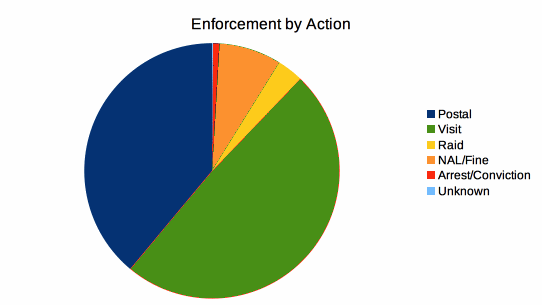A long-overdue update to the Enforcement Action Database reveals that the FCC’s conducted more than 130 enforcement actions against pirate stations this year – nearly apace for all of 2005, when the FCC first began taking an administratively tougher stance on unlicensed broadcasting in a post-LPFM world. If this rate of activity stays constant the year could very well end on the north side of 400 enforcement actions.
 I call the FCC’s posture on pirate radio “administratively tougher” because, as the raw data shows, the agency has a hard time escalating its enforcement protocol. The duration between initial site-visit and follow-up warning letter is now in the 10-day range. Sometimes the period between a warning letter and fine can be as short as a month.
I call the FCC’s posture on pirate radio “administratively tougher” because, as the raw data shows, the agency has a hard time escalating its enforcement protocol. The duration between initial site-visit and follow-up warning letter is now in the 10-day range. Sometimes the period between a warning letter and fine can be as short as a month.
But the FCC continues a relatively recent practice of sending multiple warning letters to parties involved in the same station, which somewhat inflates the appearance of action. This includes, for example, warning letters sent out to three separate people as part of an investigation into a single station in California, as well as three warning letters sent to the same person in conjunction with the operation of three microstations in two states (including the first-ever documented report of action in Wyoming).
So far, the FCC has threatened three people with fines of $10,000 each, and has actually followed through with forfeitures against eight folks for a total of $41,950. However, some of these are actually settlements of cases in which the busted broadcaster demonstrated an inability to pay, which subsequently (and statutorily) forced the FCC to revise the fine downward, in one case to as low as $250. Orders such as these account for at least half of all forfeitures issued this year, some of which involve cases first opened in 2003. Even the most recent fines stem from investigations carried over from last year. There is no current data on whether the FCC’s abysmal forfeiture collection rate has improved.
There have been two raids and three arrests so far in 2007 for running pirate stations in Florida, where the state’s considered unlicensed broadcasting a felony since 2004, and sporadic busts are relatively common. The local cops try to do the FCC’s job, but with jackboots on. Still, nobody’s yet been directly convicted under Florida’s anti-pirate law, and there’s no shortage of stations on the air in Miami, Orlando, Tampa, and elsewhere.
Overall, if one considers increased enforcement as an indicator of station proliferation, unlicensed broadcast activity may be nearing levels not seen since the modern microradio movement’s first heyday in the mid-1990s. The Enforcement Action Database only tracks FCC activity against those stations it both knows about and has the time and resources to bother. Even then, the radio cops have a hard time escalating cases beyond a knock, warning letter, and shakedown request. If you factor in the nebulous number of stations that continue to operate both above and below the FCC’s radar, coupled with the spread of activity on the AM and Shortwave bands and into new states, it’s quite the vibrant scene.
Skip to content